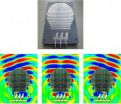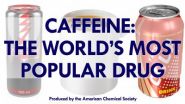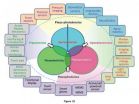(Press-News.org) WASHINGTON D.C., April 14, 2014 -- By depositing an array of tiny, metallic, U-shaped structures onto a dielectric material, a team of researchers in China has created a new artificial surface that can bend and focus electromagnetic waves the same way an antenna does.
This breakthrough, which the team is calling the first broadband transformation optics metasurface lens, may lead to the creation of new types of antennas that are flat, ultra low-profile or conformal to the shape of curved surfaces.
The new lens, described in AIP Publishing's journal Applied Physics Letters, was fabricated by Tie Jun Cui and colleagues at Southeast University in Nanjing, China and is an example of a metasurface or metamaterial -- an artificial material engineered in the lab that has properties not found in nature. In this case, by coating the surface with the tiny U-shaped elements, it acquires properties that mimic something known as a Luneburg lens.
First discovered in the 1940s Luneburg lenses are traditionally spherical optics that interact with light in an unusual way. Most lenses are made of a single material like plastic or glass that bends light passing through in a consistent, characteristic way -- a key characteristic of the material, which is called its "index of refraction." Some materials, like glass, have a higher index of refraction and bend light more than other materials -- such as quartz.
A Luneburg lens has the unusual property of bending light more or less depending on where the light strikes the lens. This is because in a Luneburg lens, the index of refraction varies across the spherical lens body, making it very different than a normal lens. Luneburg lenses can focus light or incoming electromagnetic waves to an off-axis point at the edge of the lens (not directly in front or behind it as a normal lens would do). Or they can uniformly channel electromagnetic waves emanating from a nearby point source and radiate them in a single direction -- something no spherical lens can do.
Because of their properties, Luneburg lenses find a variety of applications as radar reflectors and microwave antennae. However, the spherical shape of a typical Luneburg lens is inconvenience in some applications, Cui said, which is why he and his colleagues used inhomogeneous artificial structures to create a flat surface that acts like a Luneburg lens.
The new work compliments the traditional way of constructing Luneburg lenses based on geometric optics -- as well as a second way discovered in the last few years that uses holographic optics.
"We now have three systematical designing methods to manipulate the surface waves with inhomogeneous metasurfaces, the geometric optics, holographic optics, and transformation optics," Cui said. "These technologies can be combined to exploit more complicated applications."
INFORMATION:
The article, "A broadband transformation-optics metasurface lens" by Xiang Wan, Wei Xiang Jiang, Hui Feng Ma, and Tie Jun Cui appears on the cover of the journal Applied Physics Letters on April 14, 2014 (DOI: 10.1063/1.4870809). After that date it can be accessed at: http://scitation.aip.org/content/aip/apl/104/15/10.1063/1.4870809
ABOUT THE JOURNAL
Applied Physics Letters features concise, rapid reports on significant new findings in applied physics. The journal covers new experimental and theoretical research on applications of physics phenomena related to all branches of science, engineering, and modern technology. See: http://apl.aip.org
Device turns flat surface into spherical antenna
Broadband transformational optics lens, described in Applied Physics Letters, may lead to antenna dishes that are flat or conform to any surface
2014-04-14
ELSE PRESS RELEASES FROM THIS DATE:
The science of caffeine, the world's most popular drug (video)
2014-04-14
WASHINGTON, April 14, 2014 — It seems there are new caffeine-infused products hitting the shelves every day. From energy drinks to gum and even jerky, our love affair with that little molecule shows no signs of slowing. In the American Chemical Society's (ACS') latest Reactions video, we look at the science behind the world's most popular drug, including why it keeps you awake and how much caffeine is too much. The video is available at http://youtu.be/YuJOhpNS0IY.
INFORMATION:
Subscribe to the series at Reactions YouTube, and follow us on Twitter @ACSreactions to be ...
Study gives high marks to NC Pre-K program
2014-04-14
Scientists from UNC's Frank Porter Graham Child Development Institute have released their new study of NC Pre-K, the state's program to prepare four-year-olds for success in kindergarten. According to FPG's report, students enrolled in NC Pre-K show significant gains across all areas of learning.
"Children are progressing at an even greater rate during their participation in NC Pre-K than expected for normal developmental growth," said senior scientist Ellen Peisner-Feinberg, who leads the FPG team that has studied the program and provided it with recommendations for ...
Low birth weight, less breastfeeding create later health risks
2014-04-14
Lower weight babies and babies who aren't breastfed or not breastfed for long are at greater risk of developing chronic inflammation and related health problems later in life, according to a new study.
"There were good reasons to hypothesize that breastfeeding was important to influencing levels of inflammation in adulthood," says Thomas McDade (Northwestern University), a CIFAR (Canadian Institute for Advanced Research) Fellow in the Child & Brain Development program. "It changes the microbiome. It promotes development of the immune system. Children who are breastfed ...
Antibiotics alone are a successful treatment for uncomplicated acute appendicitis in kids
2014-04-14
Using antibiotics alone to treat children with uncomplicated acute appendicitis is a reasonable alternative to surgery that leads to less pain and fewer missed school days, according to a pilot study. The research, led by a team at Nationwide Children's Hospital and published online April 12 in the Journal of the American College of Surgeons, is the first prospective study on nonoperative management of acute appendicitis in pediatric patients in the United States.
Researchers enrolled 77 patients age 7 to 17 who were diagnosed with uncomplicated acute appendicitis by ...
Irrational health beliefs linked to skipping cardiac rehab sessions
2014-04-14
COLUMBUS, Ohio – Heart patients with beliefs about health that aren't based on medical evidence are more likely to skip sessions of cardiac rehabilitation, new research suggests.
In the Ohio State University study, a higher number of these beliefs – referred to as "irrational health beliefs" on a standard measure of these thoughts – was associated with lower adherence to a prescribed cardiac rehab program.
Among the irrational beliefs assessed: Doubting the preventive power of the flu vaccine or believing, based on family history alone, that it's safe to smoke cigarettes ...
Three new species of yellow-shouldered bats discovered in museum collections
2014-04-14
Scientists at Chicago's Field Museum and international collaborators have reconstructed the phylogeny and biological history for the Yellow-shouldered bats in the New World tropics, the region of the Earth surrounding the equator. In-depth analysis of mitochondrial and nuclear DNA sequences uncovered three species new to science, each having previously been confused with another species. Since 1960, when modern studies on this group began, Sturnira has grown from eight species to 22. The newest additions were described in a new study, published online in ZooKeys.
The ...
Ex vivo efficacy of C1s antibody as Complement inhibitor in cold agglutinin disease
2014-04-14
SOUTH SAN FRANCISCO, Calif.--True North Therapeutics, Inc., announced today a publication demonstrating that the company's C1s antibody prevents the destruction of human red blood cells exposed to plasma samples of patients with a type of autoimmune hemolytic anemia (AIHA). The article entitled "TNT003, an inhibitor of the serine protease C1s, prevents complement activation induced by cold agglutinin disease patient autoantibodies" was published on-line in the journal Blood earlier this month. TNT003 is the murine analog of True North's lead humanized monoclonal antibody ...
Neuroscientists: Brain activity may mark the beginning of memories
2014-04-14
By tracking brain activity when an animal stops to look around its environment, neuroscientists at the Johns Hopkins University believe they can mark the birth of a memory.
Using lab rats on a circular track, James Knierim, professor of neuroscience in the Zanvyl Krieger Mind/Brain Institute at Johns Hopkins, and a team of brain scientists noticed that the rats frequently paused to inspect their environment with head movements as they ran. The scientists found that this behavior activated a place cell in their brain, which helps
the animal construct a cognitive map, ...
Piezotronics and piezo-phototronics leading to unprecedented active electronics and optoelectronics
2014-04-14
New technologies for developing electronics and optoelectronics with tunable/adaptive functionalities and performance are critical to emerging applications in wearable technology, communication, pervasive computing, human-machine interfacing and biomedical diagnostics, in which the active and adaptive interactions between devices and stimuli from the ambient/host (e. g. human body) are essential. Mechanical stimuli are ubiquitous and abundant in the environment for interacting with or controlling these electronics/optoelectronics. This is, however, not facile to implement ...
Quantum manipulation: Filling the gap between quantum and classical world
2014-04-14
Quantum superposition is a fundamental and also intriguing property of the quantum world. Because of superposition, a quantum system can be in two different states simultaneously, like a cat that can be both "dead" and "alive" at the same time. However, this anti-intuitive phenomenon cannot be observed directly, because whenever a classical measuring tool touches a quantum system, it immediately collapse into a classical state. On the other hand, quantum superposition is also the core of quantum computer's enormous computational power. A quantum computer can easily break ...
LAST 30 PRESS RELEASES:
First ‘Bible map’ published 500 years ago still influences how we think about borders
Why metabolism matters in Fanconi anemia
Caribbean rainfall driven by shifting long-term patterns in the Atlantic high-pressure system, study finds
Potential treatment to bypass resistance in deadly childhood cancer
RSV vaccines could offer protection against asthma
Group 13 elements: the lucky number for sustainable redox agents?
Africa’s forests have switched from absorbing to emitting carbon, new study finds
Scientists develop plastics that can break down, tackling pollution
What is that dog taking? CBD supplements could make dogs less aggressive over time, study finds
Reducing human effort in rating software
Robots that rethink: A SMU project on self-adaptive embodied AI
Collaborating for improved governance
The 'black box' of nursing talent’s ebb and flow
Leading global tax research from Singapore: The strategic partnership between SMU and the Tax Academy of Singapore
SMU and South Korea to create seminal AI deepfake detection tool
Strengthening international scientific collaboration: Diamond to host SESAME delegation from Jordan
Air pollution may reduce health benefits of exercise
Ancient DNA reveals a North African origin and late dispersal of domestic cats
Inhibiting a master regulator of aging regenerates joint cartilage in mice
Metronome-trained monkeys can tap to the beat of human music
Platform-independent experiment shows tweaking X’s feed can alter political attitudes
Satellite data reveal the seasonal dynamics and vulnerabilities of Earth’s glaciers
Social media research tool can lower political temperature. It could also lead to more user control over algorithms.
Bird flu viruses are resistant to fever, making them a major threat to humans
Study: New protocol for Treg expansion uses targeted immunotherapy to reduce transplant complications
Psychology: Instagram users overestimate social media addiction
Climate change: Major droughts linked to ancient Indus Valley Civilization’s collapse
Hematological and biochemical serum markers in breast cancer: Diagnostic, therapeutic, and prognostic significance
Towards integrated data model for next-generation bridge maintenance
Pusan National University researchers identify potential new second-line option for advanced biliary tract cancer
[Press-News.org] Device turns flat surface into spherical antennaBroadband transformational optics lens, described in Applied Physics Letters, may lead to antenna dishes that are flat or conform to any surface




